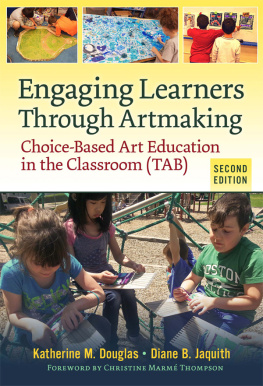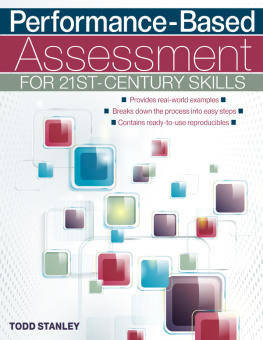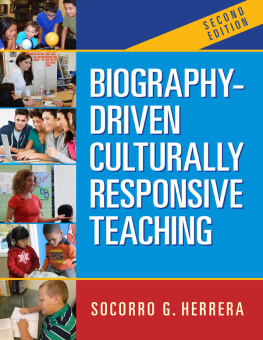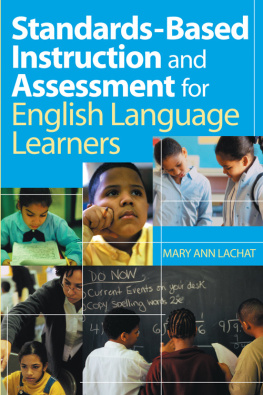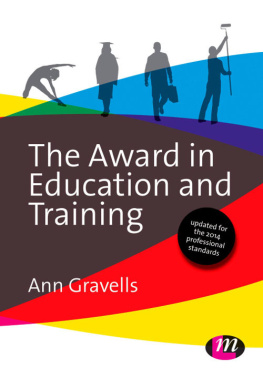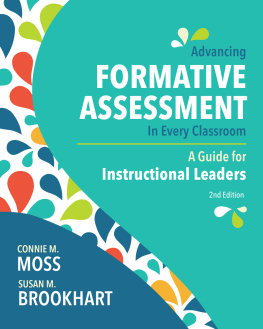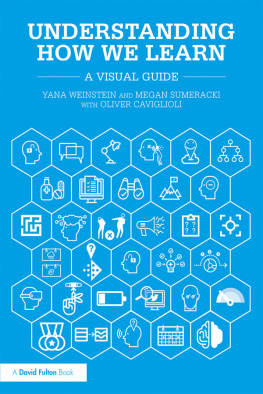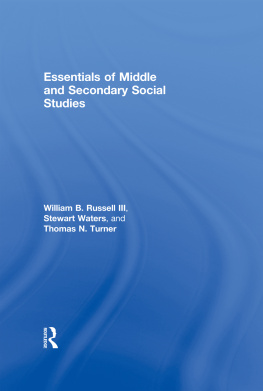Engaging Learners Through Artmaking
Choice-Based Art Education in the Classroom (TAB)
Second Edition
Katherine M. Douglas Diane B. Jaquith
Foreword by Christine Marm Thompson

Published by Teachers College Press, 1234 Amsterdam Avenue, New York, NY 10027
Copyright 2018 by Katherine M. Douglas and Diane B. Jaquith
Cover photos by Diane B. Jaquith
Material from Sidebar 12.1 reprinted with permission from School Arts , Davis Publishing. 2006.
Material from Figure 2.1 reprinted with permission from Arts & Activities magazine 2015. Material from Sidebar 9.2 reprinted with permission from Arts & Activities magazine. 2014. Reference: artsandactivities.com
All rights reserved. No part of this publication may be reproduced or transmitted in any form or by any means, electronic or mechanical, including photocopy, or any information storage and retrieval system, without permission from the publisher. For reprint permission and other subsidiary rights requests, please contact Teachers College Press, Rights Dept.: tcpressrights@tc.columbia.edu
Library of Congress Cataloging-in-Publication Data
Names: Douglas, Katherine M., author. | Jaquith, Diane B., author. | Thompson, Christine Marm, writer of foreword. |
Title: Engaging learners through artmaking: choice-based art education in the classroom (TAB) / Katherine M. Douglas, Diane B. Jaquith; foreword to the second edition by Christine M. Thompson; foreword to the first edition by George Szekely; preface by John V. Crowe.
Description: Second edition. | New York: Teachers College Press, 2018. | Includes bibliographical references and index. Identifiers: LCCN 2017051563 |
ISBN 9780807758915 (pbk. : alk. paper) Subjects: LCSH: ArtStudy and teaching (Elementary) | ArtStudy and teaching (Secondary) Classification: LCC N350 .D6 2018 | DDC 700.71dc23
LC record available at https://lccn.loc.gov/2017051563
ISBN 978-0-8077-5891-5 (paper)
ISBN 978-0-8077-7680-3 (ebook)
This book is dedicated to the youngest artists in our families, Sydney, Taylor, and Fiona, who inspire us daily through their curiosity, play, and wisdom.
Contents
Christine Marm Thompson
Foreword
How exciting to welcome this second edition of Engaging Learners Through Artmaking: Choice-Based Art Education in the Classroom (TAB). From the beginning of their quest to introduce a practical and purposeful alternative to traditional practices in art education , Katherine Douglas and Diane Jaquith have been remarkably responsive to the questions raised by art teachers about their modest but game-changing proposition for art education. They have conscientiously answered these questions, online and in person. And now they do so in print, incorporating selections from an expanding array of examples of choice-based art education in practice in contemporary classrooms, from preschool through high school. Clearly organized and directly addressed to a broad audience within the community of art educators, this book documents an ongoing conversation among professionals, pervaded by the pragmatism of insiders and the vision of those who have devoted great thought to what art education can and should be in the lives of children and teachers. Engaging Learners Through Artmaking invites art teachers to engage in shop talk, to listen to ideas about a different way of teaching, and to share their reservations, their interest, and their experiences with opening up their classrooms to accommodate student choices.
What does it mean to give students choices in their education? As Marilyn Zurmuehlen (1974) wrote many years ago, The person who is making the decisions is the person who is learning (p. 9). Art teachers learn to plan activities for students, to teach them skills and techniques and terminology, to help them create work that appears polished to an adult eye. Planning curriculum is an immensely enjoyable, challenging, and often rewarding pursuit; our students are often impressed by what they have accomplished, and administrators, colleagues, and parents applaud our ability as teachers to get such great work out of those kids. And it is not always easy to do: Some kids are just plain disengaged, for a multitude of reasons often unknown to us. And every so often we stop to wonder: What is it that we are teaching children when we teach art in the form of projects whose outcomes we can describe in advance, which unfold through a series of predetermined steps to result in products that are virtually identical?
This is perhaps the most fundamental question in art education: What do we teach when we teach art? Does our pedagogy support our intentions? Are our students coming to understand what art is and what it offers?
Often, it must be said, releasing the reins of control over decisions in the art classroom is as much an act of desperation as it is nobility, at least in my experience. In my first year of teaching elementary and middle school art in a small Midwestern town, I confronted the dilemma of how to plan for 750 students each week, including two sections of an 8th-grade elective that met twice each week for an hour. These two groups of students could not have been more different from each other. Reflecting the class differences that characterized the town itself, the band kids and the non-band kids had virtually nothing in common. What I planned for one group was met with scorn by the other. Desperately seeking a solution, I decided to offer a more open studio format, structured in the sense that there were a limited number of centers available at any one time, but the students could choose what they learned and what they made. And it worked beautifully. Eighth grade became the most rewarding part of my busy days.
Why did this work when all else had failed? In the intervening years, that question has guided much of my teaching, reading, and research; it has led me to seek, and to find, kindred spirits such as Katherine Douglas and Diane Jaquith. I believe that both art and children are best served when art education hews most closely to the strengths of art and children, when we teach for artistic behavior, as this text advises. Respect for childrens capacity to make choices; recognition that they come to us with lives in progress, interests that drive them, questions that matter; and faith that children recognize and respond well to the confidence we place in them inform this approach to teaching. Art becomes what it must be, an open exploration that proceeds in unpredictable and messy ways toward never-before-seen possibilities; projects are self-initiated, socially compelling, generating fresh inspiration as they unfold. And, as Paul Duncum (2002) put it so well, teachers become what they are: artists, consultants, guides, experts in art, and advocates for children. In the olden days, we might have labeled choice-based art education simply an authentic way of teaching art.
The first edition of Engaging Learners Through Art-Making : Choice-Based Art Education has long been required reading in the undergraduate practicum course that I teach at Penn State. Students tend to be polite but reticent as we begin to discuss the text early each semester. They dutifully share what they gleaned from the reading, but seldom offer their own response to the ideas presented in the textuntil, that is, I pose the question: Well, what did you think? Is this crazy talk? At that point, the pressure released, we begin to discuss the possibilities and pitfalls of Teaching for Artistic Behavior (TAB). My side of the conversation represents possibilities; my students side represents, largely, pitfalls:

